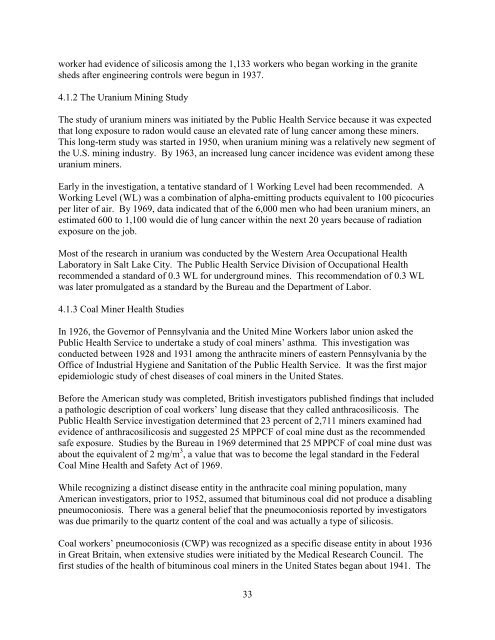One Hundred Years of Federal Mining Safety and Health Research
One Hundred Years of Federal Mining Safety and Health Research
One Hundred Years of Federal Mining Safety and Health Research
- No tags were found...
Create successful ePaper yourself
Turn your PDF publications into a flip-book with our unique Google optimized e-Paper software.
worker had evidence <strong>of</strong> silicosis among the 1,133 workers who began working in the granite<br />
sheds after engineering controls were begun in 1937.<br />
4.1.2 The Uranium <strong>Mining</strong> Study<br />
The study <strong>of</strong> uranium miners was initiated by the Public <strong>Health</strong> Service because it was expected<br />
that long exposure to radon would cause an elevated rate <strong>of</strong> lung cancer among these miners.<br />
This long-term study was started in 1950, when uranium mining was a relatively new segment <strong>of</strong><br />
the U.S. mining industry. By 1963, an increased lung cancer incidence was evident among these<br />
uranium miners.<br />
Early in the investigation, a tentative st<strong>and</strong>ard <strong>of</strong> 1 Working Level had been recommended. A<br />
Working Level (WL) was a combination <strong>of</strong> alpha-emitting products equivalent to 100 picocuries<br />
per liter <strong>of</strong> air. By 1969, data indicated that <strong>of</strong> the 6,000 men who had been uranium miners, an<br />
estimated 600 to 1,100 would die <strong>of</strong> lung cancer within the next 20 years because <strong>of</strong> radiation<br />
exposure on the job.<br />
Most <strong>of</strong> the research in uranium was conducted by the Western Area Occupational <strong>Health</strong><br />
Laboratory in Salt Lake City. The Public <strong>Health</strong> Service Division <strong>of</strong> Occupational <strong>Health</strong><br />
recommended a st<strong>and</strong>ard <strong>of</strong> 0.3 WL for underground mines. This recommendation <strong>of</strong> 0.3 WL<br />
was later promulgated as a st<strong>and</strong>ard by the Bureau <strong>and</strong> the Department <strong>of</strong> Labor.<br />
4.1.3 Coal Miner <strong>Health</strong> Studies<br />
In 1926, the Governor <strong>of</strong> Pennsylvania <strong>and</strong> the United Mine Workers labor union asked the<br />
Public <strong>Health</strong> Service to undertake a study <strong>of</strong> coal miners’ asthma. This investigation was<br />
conducted between 1928 <strong>and</strong> 1931 among the anthracite miners <strong>of</strong> eastern Pennsylvania by the<br />
Office <strong>of</strong> Industrial Hygiene <strong>and</strong> Sanitation <strong>of</strong> the Public <strong>Health</strong> Service. It was the first major<br />
epidemiologic study <strong>of</strong> chest diseases <strong>of</strong> coal miners in the United States.<br />
Before the American study was completed, British investigators published findings that included<br />
a pathologic description <strong>of</strong> coal workers’ lung disease that they called anthracosilicosis. The<br />
Public <strong>Health</strong> Service investigation determined that 23 percent <strong>of</strong> 2,711 miners examined had<br />
evidence <strong>of</strong> anthracosilicosis <strong>and</strong> suggested 25 MPPCF <strong>of</strong> coal mine dust as the recommended<br />
safe exposure. Studies by the Bureau in 1969 determined that 25 MPPCF <strong>of</strong> coal mine dust was<br />
about the equivalent <strong>of</strong> 2 mg/m 3 , a value that was to become the legal st<strong>and</strong>ard in the <strong>Federal</strong><br />
Coal Mine <strong>Health</strong> <strong>and</strong> <strong>Safety</strong> Act <strong>of</strong> 1969.<br />
While recognizing a distinct disease entity in the anthracite coal mining population, many<br />
American investigators, prior to 1952, assumed that bituminous coal did not produce a disabling<br />
pneumoconiosis. There was a general belief that the pneumoconiosis reported by investigators<br />
was due primarily to the quartz content <strong>of</strong> the coal <strong>and</strong> was actually a type <strong>of</strong> silicosis.<br />
Coal workers’ pneumoconiosis (CWP) was recognized as a specific disease entity in about 1936<br />
in Great Britain, when extensive studies were initiated by the Medical <strong>Research</strong> Council. The<br />
first studies <strong>of</strong> the health <strong>of</strong> bituminous coal miners in the United States began about 1941. The<br />
33
















